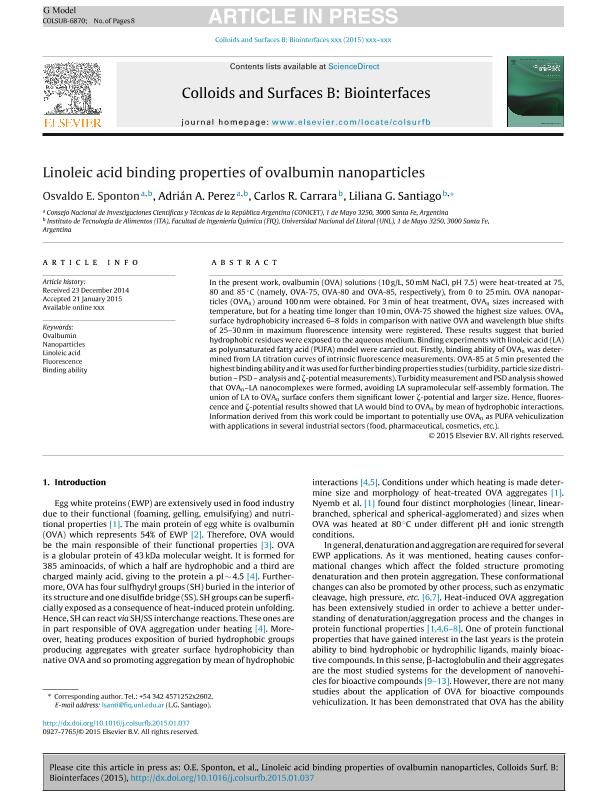Artículo
Linoleic acid binding properties of ovalbumin nanoparticles
Fecha de publicación:
04/2015
Editorial:
Elsevier Science
Revista:
Colloids and Surfaces B: Biointerfaces
ISSN:
0927-7765
Idioma:
Inglés
Tipo de recurso:
Artículo publicado
Clasificación temática:
Resumen
In the present work, ovalbumin (OVA) solutions (10 g/L, 50 mM NaCl, pH 7.5) were heat-treated at 75, 80 and 85°C (namely, OVA-75, OVA-80 and OVA-85, respectively), from 0 to 25 min. OVA nanoparticles (OVAn) around 100 nm were obtained. For 3 min of heat treatment, OVAn sizes increased with temperature, but for a heating time longer than 10 min, OVA-75 showed the highest size values. OVAn surface hydrophobicity increased 6-8 folds in comparison with native OVA and wavelength blue shifts of 25-30 nm in maximum fluorescence intensity were registered. These results suggest that buried hydrophobic residues were exposed to the aqueous medium. Binding experiments with linoleic acid (LA) as polyunsatured fatty acid (PUFA) model were carried out. Firstly, binding ability of OVAn was determined from LA titration curves of intrinsic fluorescence measurements. OVA-85 at 5 min presented the highest binding ability and it was used for further binding properties studies (turbidity, particle size distribution -PSD- analysis and ζ-Potential measurements). Turbidity measurement and PSD analysis showed that OVAn-LA nanocomplexes were formed, avoiding LA supramolecular self-assembly formation. The union of LA to OVAn surface confers them significant lower ζ-Potential and larger size. Hence, fluorescence and ζ-Potential results showed that LA would bind to OVAn by mean of hydrophobic interactions. Information derived from this work could be important for potential uses of OVAn for vehiculization of PUFA with applications in several industrial sectors (food, pharmaceutical, cosmetics, etc.).
Palabras clave:
Ovalbumin
,
Nanoparticles
,
Linoleic Acid
,
Fluorescence
,
Binding Ability
Archivos asociados
Licencia
Identificadores
Colecciones
Articulos(CCT - SANTA FE)
Articulos de CTRO.CIENTIFICO TECNOL.CONICET - SANTA FE
Articulos de CTRO.CIENTIFICO TECNOL.CONICET - SANTA FE
Citación
Sponton, Osvaldo Ernesto; Perez, Adrián Alejandro; Carrara, Carlos Roberto; Santiago, Liliana G.; Linoleic acid binding properties of ovalbumin nanoparticles; Elsevier Science; Colloids and Surfaces B: Biointerfaces; 128; 4-2015; 219-226
Compartir
Altmétricas




